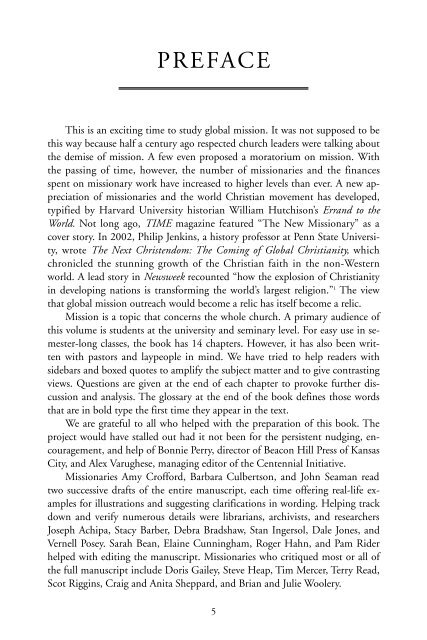discovering missions - Southern Nazarene University
discovering missions - Southern Nazarene University
discovering missions - Southern Nazarene University
Create successful ePaper yourself
Turn your PDF publications into a flip-book with our unique Google optimized e-Paper software.
245187 Disc Missions ins 9/6/07 1:04 PM Page 5<br />
PREFACE<br />
This is an exciting time to study global mission. It was not supposed to be<br />
this way because half a century ago respected church leaders were talking about<br />
the demise of mission. A few even proposed a moratorium on mission. With<br />
the passing of time, however, the number of missionaries and the finances<br />
spent on missionary work have increased to higher levels than ever. A new appreciation<br />
of missionaries and the world Christian movement has developed,<br />
typified by Harvard <strong>University</strong> historian William Hutchison’s Errand to the<br />
World. Not long ago, TIME magazine featured “The New Missionary” as a<br />
cover story. In 2002, Philip Jenkins, a history professor at Penn State <strong>University</strong>,<br />
wrote The Next Christendom: The Coming of Global Christianity, which<br />
chronicled the stunning growth of the Christian faith in the non-Western<br />
world. A lead story in Newsweek recounted “how the explosion of Christianity<br />
in developing nations is transforming the world’s largest religion.” 1 The view<br />
that global mission outreach would become a relic has itself become a relic.<br />
Mission is a topic that concerns the whole church. A primary audience of<br />
this volume is students at the university and seminary level. For easy use in semester-long<br />
classes, the book has 14 chapters. However, it has also been written<br />
with pastors and laypeople in mind. We have tried to help readers with<br />
sidebars and boxed quotes to amplify the subject matter and to give contrasting<br />
views. Questions are given at the end of each chapter to provoke further discussion<br />
and analysis. The glossary at the end of the book defines those words<br />
that are in bold type the first time they appear in the text.<br />
We are grateful to all who helped with the preparation of this book. The<br />
project would have stalled out had it not been for the persistent nudging, encouragement,<br />
and help of Bonnie Perry, director of Beacon Hill Press of Kansas<br />
City, and Alex Varughese, managing editor of the Centennial Initiative.<br />
Missionaries Amy Crofford, Barbara Culbertson, and John Seaman read<br />
two successive drafts of the entire manuscript, each time offering real-life examples<br />
for illustrations and suggesting clarifications in wording. Helping track<br />
down and verify numerous details were librarians, archivists, and researchers<br />
Joseph Achipa, Stacy Barber, Debra Bradshaw, Stan Ingersol, Dale Jones, and<br />
Vernell Posey. Sarah Bean, Elaine Cunningham, Roger Hahn, and Pam Rider<br />
helped with editing the manuscript. Missionaries who critiqued most or all of<br />
the full manuscript include Doris Gailey, Steve Heap, Tim Mercer, Terry Read,<br />
Scot Riggins, Craig and Anita Sheppard, and Brian and Julie Woolery.<br />
5

















